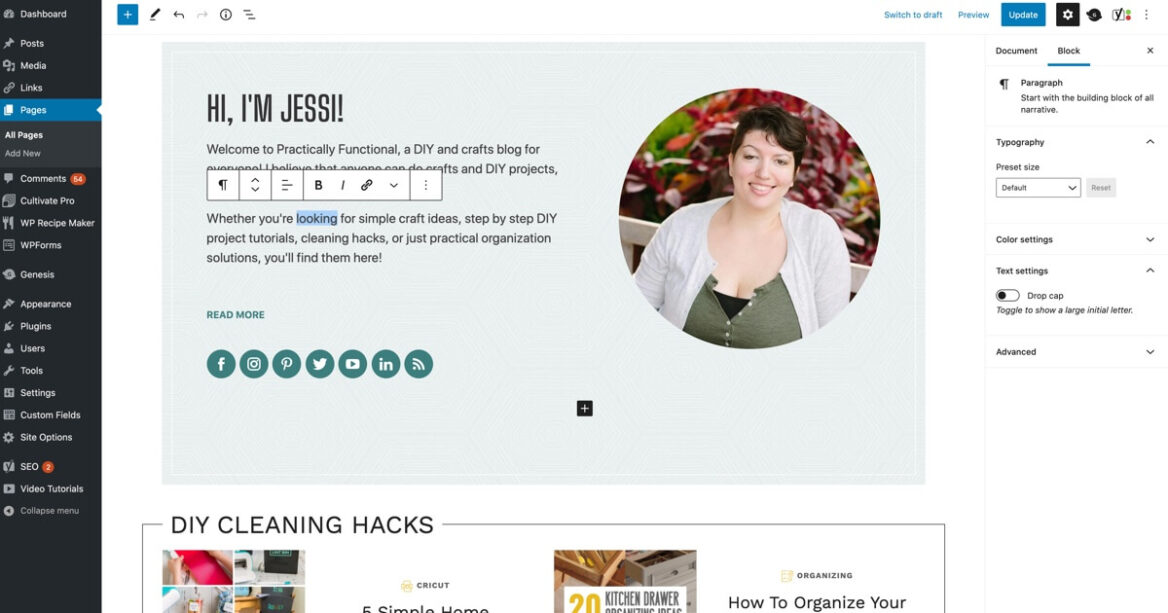
My favorite new feature in Advanced Custom Fields 5.9 is support for InnerBlocks. This allows you to insert any block (core or custom) inside your ACF block.
Rather than having to create your own fields for Title, Content, and Button in your custom block, you can simply insert <InnerBlocks /> and use the block editor to build the content inside the block.
Table of Contents
How to use InnerBlocks
When registering your ACF block, include 'jsx' => true in the supports array.
acf_register_block_type( array(
'title' => __( 'About', 'client_textdomain' ),
'name' => 'about',
'render_template' => 'partials/blocks/about.php',
'mode' => 'preview',
'supports' => [
'align' => false,
'anchor' => true,
'customClassName' => true,
'jsx' => true,
]
));
In your template partial for the block, include <InnerBlocks /> where you would like the editable block area to appear.
$classes = ['block-about'];
if( !empty( $block['className'] ) )
$classes = array_merge( $classes, explode( ' ', $block['className'] ) );
$anchor = '';
if( !empty( $block['anchor'] ) )
$anchor = ' id="' . sanitize_title( $block['anchor'] ) . '"';
echo '<div class="' . join( ' ', $classes ) . '"' . $anchor . '>';
echo '<div class="block-about__inner">';
echo '<div class="block-about__content">';
echo '<InnerBlocks />';
echo '</div>';
echo '<div class="block-about__image">';
echo wp_get_attachment_image( get_field( 'image' ), 'be_thumbnail_l' );
echo '</div>';
echo '</div>';
echo '</div>';
Default value for InnerBlocks
It’s helpful to fill the InnerBlocks field with default content so the block looks correct when first inserted.
We’re building a new site for Nice Kicks, and they often need to highlight the release date and details for new sneakers. We built a Release Info block that uses InnerBlocks for the content area.
Rather than just having an empty white box when they first insert the block, we pre-populate it with default content using a block template.
Inside the block’s template file, create a $template array detailing which blocks should be added. Update <InnerBlocks /> to include the template.
You can find the available block attributes in a blocks.json file for each block in wp-includes/blocks.
$template = array(
array('core/heading', array(
'level' => 2,
'content' => 'Title Goes Here',
)),
array( 'core/paragraph', array(
'content' => '<strong>Colorway:</strong> <br /><strong>Style Code:</strong> <br /><strong>Release Date:</strong> <br /><strong>MSRP:</strong> ',
) )
);
echo '<div class="' . join( ' ', $classes ) . '"' . $anchor . '>';
echo '<InnerBlocks template="' . esc_attr( wp_json_encode( $template ) ) . '" />';
$form_id = get_option( 'options_be_release_info_form' );
if( !empty( $form_id ) && function_exists( 'wpforms_display' ) )
wpforms_display( $form_id, true, true );
echo '</div>';
Placeholders instead of default content
In the above example we set the starting content for the block. If you were to publish the post without changing the text, the default content would appear in the blocks.
Alternatively, you can use the placeholder parameter to specify placeholder text. This will not be published, and when you select the field the placeholder text disappears.
I had two issues with placeholders, which is why I used default content instead:
- When you insert the block, the first block inside InnerBlocks is selected so its placeholder text is not visible. You have to insert the block then click outside the block to see the placeholder text.
- The placeholder field does not support HTML. In my use case, we used
<strong>and<br />to format the paragraph text, but that doesn’t work with the placeholder.
To use placeholders with the above example, change the $template to
$template = array(
array('core/heading', array(
'level' => 2,
'placeholder' => 'Title Goes Here',
)),
array( 'core/paragraph', array(
'placeholder' => '<strong>Colorway:</strong> <br /><strong>Style #:</strong> <br /><strong>Release Date:</strong> <br /><strong>Price:</strong> ',
) )
);And this was the result:
Limit the blocks available in InnerBlocks
You can limit which blocks can be inserted into your InnerBlocks field using the allowedBlocks attribute.
Using the example above, I can limit the Release Info block to only include the heading and paragraph blocks:
$allowed_blocks = array( 'core/heading', 'core/paragraph' );
$template = array(
array('core/heading', array(
'level' => 2,
'content' => 'Title Goes Here',
)),
array( 'core/paragraph', array(
'content' => '<strong>Colorway:</strong> <br /><strong>Style Code:</strong> <br /><strong>Release Date:</strong> <br /><strong>MSRP:</strong> ',
) )
);
echo '<div class="' . join( ' ', $classes ) . '"' . $anchor . '>';
echo '<InnerBlocks allowedBlocks="' . esc_attr( wp_json_encode( $allowed_blocks ) ) . '" template="' . esc_attr( wp_json_encode( $template ) ) . '" />';
$form_id = get_option( 'options_be_release_info_form' );
if( !empty( $form_id ) && function_exists( 'wpforms_display' ) )
wpforms_display( $form_id, true, true );
echo '</div>';
Template lock with InnerBlocks
You can also limit the flexibility by locking the template.
Adding templateLock="all" prevents inserting new blocks or removing/re-arranging current blocks
Adding templateLock="insert" prevents inserting new blocks or removing current blocks, but you can re-arrange the current blocks.
I recently built an Icon Heading block. The icon can be selected in the block settings sidebar using a dynamic dropdown field.
I used InnerBlocks for the heading itself so it would have all the standard options for customizing the heading (change block style, change heading type to h3). I used templateLock="all" so only the heading from my block template could be used in this block.
$classes = ['block-icon-heading'];
if( !empty( $block['className'] ) )
$classes = array_merge( $classes, explode( ' ', $block['className'] ) );
if( !empty( $block['align'] ) )
$classes[] = 'align' . $block['align'];
$anchor = '';
if( !empty( $block['anchor'] ) )
$anchor = ' id="' . sanitize_title( $block['anchor'] ) . '"';
$template = array(
array('core/heading', array(
'level' => 2,
'content' => 'Heading',
)),
);
echo '<div class="' . join( ' ', $classes ) . '"' . $anchor . '>';
$icon = get_field( 'dynamic_icon_category' );
if( !empty( $icon ) )
echo '<div class="icon-heading-wrap">' . be_icon( [ 'icon' => $icon, 'group' => 'category', 'size' => 38 ] ) . '</div>';
echo '<InnerBlocks template="' . esc_attr( wp_json_encode( $template ) ) . '" templateLock="all" />';
echo '</div>';
The post InnerBlocks with ACF blocks appeared first on Bill Erickson.

